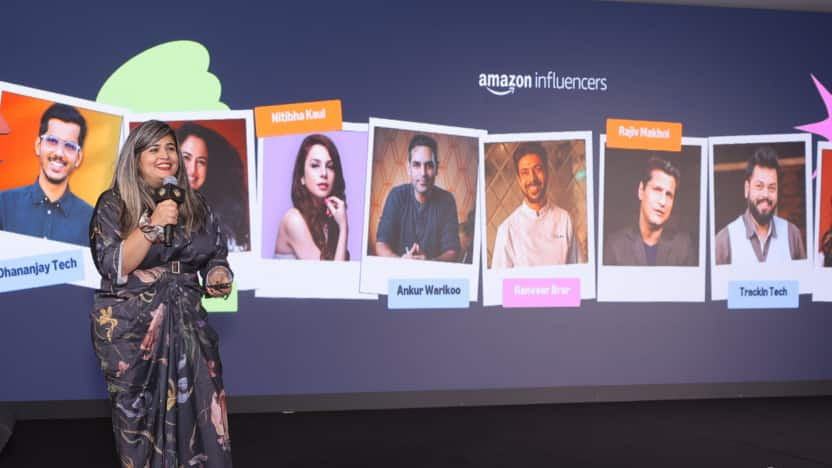Amazon’s influencer program is betting on regional and nano creators, with affiliate marketing giving them steady income streams beyond viral fame, says Nidhi Thakkar of Amazon India.

Nidhi Thakkar, Head of Creator Programs, Amazon India
Influencer marketing in India has largely been dominated by metro-based creators with million-plus followings. But the next phase of growth is coming from Tier 2 and Tier 3 cities—regional voices speaking in languages like Telugu, Bengali, or Marathi. Amazon, through its influencer programme (AIP), is trying to tap into this shift.
The company says its creator platform has grown from 60,000 to 1 lakh influencers in India, with nearly 30% of them being regional creators. “That’s a powerful way to engage audiences beyond English and Hindi. For instance, Telugu tech creators and Bengali lifestyle creators are thriving on AIP,” Nidhi Thakkar, Head of Creator Programs, Amazon India told BrandWagon Online.
Unlike platforms that measure creators largely by follower counts, Amazon’s framework is anchored in conversions. Thakkar noted that AIP is open to anyone with over 2,000 followers, and many participants begin at that threshold.
“We don’t define creators strictly by size but by their ability to influence and build authority,” she says. “For nano creators (20,000–100,000 followers), AIP often becomes their first paycheck, sometimes even matching AdSense. It’s less about reach and more about actual conversions—which is why affiliate marketing resonates so strongly with smaller creators.”
Also Read: Festive 2025: With Gaming Ads Gone, Brands Sharpen Regional and Hyperlocal Bets
For Amazon, the bet is that smaller creators can deliver more engaged audiences in regional markets where trust and relatability often matter more than celebrity appeal.
Affiliate links are not new. YouTube Shorts and Instagram allow creators to tag products directly within videos. Amazon’s claim, however, is that it offers more than just a link.
“AIP enables creators to generate affiliate links and share them on YouTube or Instagram. What sets us apart is the ecosystem of support,” Thakkar says. She points to preferential commission rates under its Tech Influencer Program, early access to products before launch, professional studio facilities, training modules through Creator University, and even brand monetisation deals.
The model, if successful, could position Amazon less as a marketplace and more as a partner in the creator economy. But whether these additional benefits translate into sustained loyalty remains to be seen, given that creators often diversify across platforms.
Amazon also integrates creator-led content into its own ecosystem, through on-site programmes like Amazon Live and shopping videos that are part of the purchase journey. The company’s economic logic is straightforward: better creator content drives better customer experiences, which can lead to higher sales.
“More sales mean higher commissions, which in turn attract more creators,” Thakkar says. She added that “60% of online purchases today are influenced by creators,” underlining why platforms like Amazon cannot ignore this space.
Also Read: We Position Ourselves Where the Money Flows: Sir Martin Sorrell of S4 Capital
Still, Amazon’s role is not that of a direct advertiser. It facilitates discovery and conversion, but creators remain dependent on their ability to sustain engagement.
Even with this support structure, creators face familiar hurdles. “Two big ones are consistency and analytics,” Thakkar says. “Sustaining a long-term career as a creator is tough. That’s why affiliate marketing provides stability with a regular income stream. The second is transparency—creators want to know what’s working. With AIP, they get granular analytics on clicks, views, and conversions.”
The availability of data is an advantage, but it doesn’t eliminate the uncertainty of audience retention or the competitive nature of social media.
In terms of content categories, Amazon sees strength in fashion and beauty, but newer verticals are emerging. “We’ve launched a home influencer programme, and parenting is another fast-emerging category because trust is so central there,” Thakkar says. “Parents rely heavily on influencers for decisions around childcare products. Beyond these, we see traction in tech, lifestyle, and finance.”
While fashion and beauty remain dominant, categories like parenting and finance highlight how influencer content is moving beyond aspirational to functional, shaping everyday purchase decisions.
As India’s e-commerce market deepens its reach into smaller towns, the demand for relatable, regional content is expected to rise. Amazon is betting that by offering creators not just commissions but also support infrastructure, it can carve out a stronger position in the influencer ecosystem.
Whether that ecosystem can compete with the scale and virality of Instagram or YouTube remains an open question. But for regional and nano creators looking for a stable entry point into the business of influence, affiliate-led commerce offers a new starting line.
Empower your business. Get practical tips, market insights, and growth strategies delivered to your inbox
By continuing you agree to our Privacy Policy & Terms & Conditions
